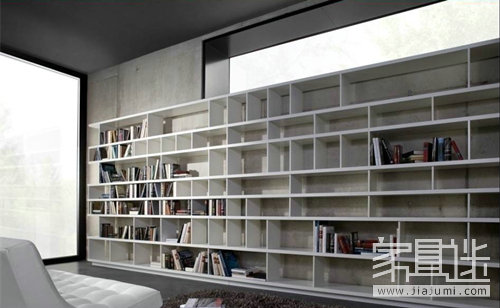Although a bookcase may not be as complex as a wardrobe or TV cabinet, selecting the right one can still be challenging. The market offers a wide range of styles, sizes, materials, and details, making it overwhelming for buyers. Additionally, choosing a bookcase is closely tied to the room size, the type of books you have, and how you plan to use it.
Currently, there are three main types of bookcases available: straight-line, U-shaped, and L-shaped. A straight-line bookcase is simply placed against the wall, while a U-shaped one forms a U by combining three flat sections and two corners. An L-shaped bookcase uses a corner in the room, creating a more efficient layout.

Among these, the straight-line bookcase is the most commonly used and suitable for various home types, which is why it's widely found in stores. U-shaped and L-shaped bookcases require more space, especially U-shaped ones, which work best in larger study areas. In smaller spaces, they might make the room feel cramped. Most single bookcases on the market are over 80 cm wide, 30-40 cm deep, and 180-220 cm tall. While the dimensions don’t vary much, your choice depends heavily on the function and available space.
If you have many books but limited space, consider a tall bookcase with an upper shelf that’s harder to reach. You can use a small, sliding ladder to access the top shelves. Floor-standing bookcases can also act as room dividers, helping to define different areas within a space.
The style of the bookcase should match its purpose. For those who collect hardcover books and want to create a classic atmosphere, wood and traditional designs are ideal. Since these books aren't used frequently, opt for a bookcase with glass or wooden doors to protect them from dust and maintain their appearance.
For remote workers, open or modular bookcases are practical choices. Modern panel bookcases allow adjustable shelf heights, making it easy to organize different types of books. Bookcases connected to a desk save space and improve accessibility, perfect for smaller living rooms.
Related reading: How to choose a comfortable desk for your family and yourself
Shopping Tips
1. Choose Based on Space Size
Depending on your home’s layout, you can choose single, double, or triple bookcases arranged in a line, L-shape, or U-shape. If you plan to display items like photo frames, albums, or artwork, go for a slightly thicker bookcase.
Tip: The width of the bookcase determines how many items it can hold. If your books come in various sizes, choose one with adjustable partitions. This allows larger books to fit comfortably. Partitions shouldn’t exceed 90 cm in length to avoid bending or deformation. It’s also recommended to keep the partition thickness between 2.5–3.5 cm for stability.
2. Select Cabinet Doors Based on Function
Bookcases come in many shapes, each with unique pros and cons. Before buying, think about whether you’ll just store books or also display them. Full cabinet doors look neat; sliding doors add a modern touch; and open designs offer visibility. If you only need storage, go for a closed design. For displays, choose open or semi-open options.
Tip: In dusty cities like Beijing, sliding doors or open designs can expose books to dust, making them harder to clean. If you want to display some items, consider using hidden doors to maintain aesthetics.
3. Choose Internal Dimensions According to Your Needs
Many bookcases on the market have fixed internal dimensions, which may not suit all book sizes. If you mostly read 32-page books, avoid oversized bookcases that waste space. Customizable internal dimensions are better for efficiency.
Tip: The height of the shelves determines the internal size. Standard 32-page books require shelves around 24–26 cm high. For 16-page books, 28–30 cm is ideal. Larger books usually need 30–33 cm in height.
4. Choose the Right Depth for Easy Access
Some people believe deeper bookcases mean more storage, but too much depth can make accessing books difficult. Also, the height of the bookcase matters. A very tall bookcase might look stylish but could be impractical for reaching the top shelves.
Tip: A depth of around 30 cm ensures stability and prevents collapse. In terms of height, 220 cm is sufficient for most families, while 240 cm might make the space feel cramped.
5. Match the Color with Room Style
Modern styles often use metal and glass textures, while wooden bookcases give a warm, sturdy feel. Light-colored bookcases bring a fresh, clean look, while dark ones offer a more elegant and sophisticated vibe.
Tip: When choosing, consider your home’s overall decor. Simple or rustic styles pair well with light wood, metal, or glass. European, vintage, or traditional styles may suit dark wood better. If your room has poor lighting, a light-colored bookcase will brighten it up. For those who don’t clean often, light-colored bookcases are easier to maintain.
6. Check for Stability and Quality
Before purchasing, check the type of wood listed on the product manual. Choose durable wood, and inspect the paint for smoothness and evenness. Smell the surface to ensure there’s no strong chemical odor. Open the doors and test the slide mechanism for smooth operation.
Tip: Shake the bookcase gently—if it feels loose, it may not be sturdy. Look for holes in the partitions, which indicate adjustability. Move the partitions to see if they’re stable or can be removed easily. High-quality bookcases are designed with special fixings or side panels that lock in place, allowing only screw-based adjustments.
Knitted Cardigan,Knitted Sweater,Cardigan Sweater,Knitted Pullover
DONGGUAN BILLION GOODTOP INDUSTRIAL CO., LTD , https://www.bgoodtop.com
![<?echo $_SERVER['SERVER_NAME'];?>](/template/twentyseventeen/skin/images/header.jpg)